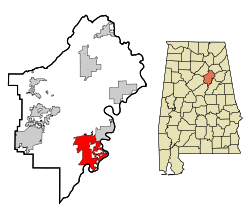Pell City, Alabama
| Pell City, Alabama | ||
|---|---|---|
| City | ||
|
||
 Location in St. Clair County and the state of Alabama |
||
| Coordinates: 33°34′15″N 86°16′26″W / 33.57083°N 86.27389°WCoordinates: 33°34′15″N 86°16′26″W / 33.57083°N 86.27389°W | ||
| Country | United States | |
| State | Alabama | |
| County | St. Clair | |
| Government | ||
| • Type | Council-manager government | |
| • Mayor | William "Bill" Pruitt | |
| Area | ||
| • Total | 27.2 sq mi (70.3 km2) | |
| • Land | 24.6 sq mi (63.6 km2) | |
| • Water | 2.6 sq mi (6.7 km2) | |
| Elevation | 597 ft (182 m) | |
| Population (2010) | ||
| • Total | 12,463 | |
| • Density | 458.2/sq mi (177.3/km2) | |
| Time zone | Central (CST) (UTC-6) | |
| • Summer (DST) | CDT (UTC-5) | |
| ZIP codes | 35125, 35128, 35054 | |
| Area code(s) | 205 | |
| FIPS code | 01-58896 | |
| GNIS feature ID | 0164801 | |
| Website | http://pell-city.com/ | |
Pell City is a city in St. Clair County, Alabama, United States. The city is the county seat of St. Clair County along with Ashville. At the 2000 census the population was 9,565. At the 2010 census, the city-limit population jumped to 12,695.
Pell City was founded in 1890 by railroad investors and named after Jonathan H. Pell of the Pell City Iron and Land Company, one of its financial backers. The city was incorporated on May 6, 1891, but nearly failed during the Panic of 1893. However, it was revived in 1902 when Sumter Cogswell built the Pell City Manufacturing Company, which subsequently became Avondale Mills, a major landmark of the town until Thunder Enterprises, a Tennessee company, bought the building and began dismantling the factory in 2008. The mill was the economic and social center of the town during its development and early growth. Besides the textile mill, other economic endeavors included agriculture and mercantile establishments. Large cotton, soybean, and cattle farms were located in the area. Pell City increased its size in 1956 when the nearby towns of Eden and Oak Ridge were merged with the city. The first mayor was Green Evans.
The residences of Sumter Cogswell and Green Evans (Pell City’s first mayor) are two of the earliest structures, dating from the late nineteenth century. The majority of the historic structures date from 1902 to 1905.
Ashville, Alabama, in the northern part of St. Clair County, was the only county seat from 1821 to 1907. A constitutional amendment in 1907 established Pell City as the second county seat. For many years, St. Clair County was the only county in the country with two full-service county seats. Both county seats remain operational to this day although Pell City has far outstripped Ashville in growth thanks in no small part to the convergence of both I-20 and Logan Martin Lake.
The construction of the Logan Martin Dam in 1964 changed the geography of the town by creating a large lake. This also created a large recreational area which brought new businesses, temporary summer residents and tourists and hundreds of new permanent residents building new homes along the new lake.
On April 8, 1998, an F2 tornado struck north of the city limits after the F5 tornado expired in western Jefferson County. This windstorm killed two people in a mobile home. It remained for 14 mi (23 km), partially damaging a church, twenty-six homes and mobile homes, and other buildings in Coal City. Ninety other homes and mobile homes suffered minor to major destruction. An additional twelve people were injured. The twister damaged a funeral home and twenty-five homes. The Bethel Baptist Church in Odenville was destroyed a few minutes after its members left an Easter pageant rehearsal that had been cancelled because of the storm.
...
Wikipedia

